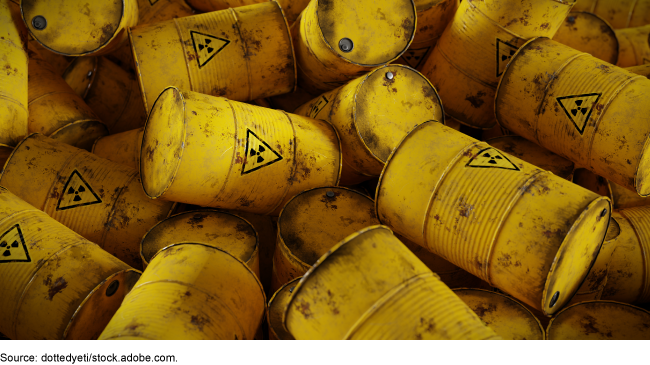Nuclear Waste Cleanup: NNSA Should Improve Its Strategy for Managing Anticipated Waste from Defense Activities
Fast Facts
Decades of nuclear weapons production have generated millions of gallons of nuclear waste, which has been challenging to manage. And, the National Nuclear Security Administration's ongoing maintenance and modernization of the nuclear weapons stockpile will generate new waste in the coming years.
But NNSA's strategy for treating, storing, and disposing of the new waste isn't comprehensive and doesn't fully address all the legal requirements. For example, NNSA hasn't identified all sources and amounts of waste that may be generated in the next 11-25 years, or coordinated plans for its disposal.
Our recommendation addresses these issues.

Highlights
What GAO Found
The National Nuclear Security Administration's (NNSA)—a separately organized agency within the Department of Energy (DOE)—February 2024 strategy for treating, storing, and disposing of the anticipated increase in nuclear waste from stockpile maintenance and modernization activities is not comprehensive and does not fully address all statutory requirements. When comparing the strategy to the seven key components of a comprehensive strategic plan, GAO found that the strategy substantially meets one key component (see table).
Analysis of How the National Nuclear Security Administration's Strategy Follows Key Components of a Comprehensive Strategic Plan
|
Key component |
GAO assessment |
|---|---|
|
Mission statement |
Substantially meets |
|
Problem definition, scope, and methodology |
Minimally meets |
|
Goals and objectives |
Minimally meets |
|
Activities, milestones, and performance measures |
Minimally meets |
|
Resources and investments |
Partially meets |
|
Organizational roles, responsibilities, and coordination |
Partially meets |
|
Key external factors |
Partially meets |
Source: GAO analysis of Department of Energy information and GAO-13-201. | GAO-25-107636
NNSA's strategy includes a mission statement, but the other key components of a comprehensive strategic plan are partially or minimally addressed. In addition, the strategy does not fully address statutory requirements. For example:
- Generated waste amounts. Though the strategy's scope is a 25-year period, the 25-year outlook does not include anticipated waste from important upcoming activities, such as reestablishing plutonium pit production capability or surplus plutonium disposition.
- Coordination with the Office of Environmental Management (EM). The strategy recommends establishing formal coordination mechanisms with EM, which has responsibilities for waste disposal, but it does not define formal coordination or describe NNSA's plans to create this mechanism.
- Cost estimates. NNSA estimated costs of about $2.5 billion over the next 5 years, but the estimate may not be reasonable, in part because NNSA used inconsistent and unclear information and did not perform risk and uncertainty analyses.
- Disposal options. The strategy did not identify disposal facilities, including any needed modifications. It states that other locations that could be used to dispose of high-risk waste should be identified or developed.
NNSA officials stated that they consider their strategy as a snapshot-in-time report that summarizes the NNSA sites' plans, rather than a plan that sites will follow in the future. Nevertheless, NNSA should include all the key components of a comprehensive strategy and fully address statutory requirements in its next strategy update. Doing so would better position NNSA to increase the probability of the strategy's success and avoid the challenges that have affected efforts to dispose of waste generated by previous atomic weapons production activities.
Why GAO Did This Study
Decades of nuclear weapons production and research generated millions of gallons of hazardous and radioactive waste. NNSA's ongoing maintenance and modernization activities of the nuclear weapons stockpile are expected to generate a considerable volume of additional waste. However, a Senate committee report questioned whether there are sufficient facilities to address the waste generated by these activities, and whether such facilities are included in current plans and budgets.
NNSA was required by statute to develop a comprehensive strategy for treating, storing, and disposing of the waste generated by these activities. In July 2022, NNSA created an office to manage the planning and execution of waste operations and disposition activities for all its missions.
A Senate committee report accompanying a bill for the National Defense Authorization Act for Fiscal Year 2022 includes a provision for GAO to assess NNSA's strategy. This report examines the extent to which NNSA's strategy is comprehensive and addresses statutory requirements. GAO reviewed documents and data from DOE and interviewed department officials.
Recommendations
GAO is recommending that NNSA include the key components of a comprehensive strategic plan and fully address statutory requirements in its required update to congressional committees with the President's budget request for fiscal year 2027.
NNSA concurred with this recommendation.
Recommendations for Executive Action
| Agency Affected | Recommendation | Status |
|---|---|---|
| National Nuclear Security Administration | The NNSA Administrator should include the key components of a comprehensive strategic plan and fully address statutory requirements in its update to the strategy for treating, storing, and disposing of waste resulting from stockpile maintenance and modernization activities, which NNSA must submit to congressional defense committees concurrent with the President's budget request for fiscal year 2027. The strategy update should include, among other things, the amounts and types of the anticipated waste and reasonable cost estimates for the entire 25-year period of the strategy, and a coordination mechanism with EM that incorporates leading practices for enhancing interagency collaboration. (Recommendation 1) |
When we confirm what actions the agency has taken in response to this recommendation, we will provide updated information.
|
